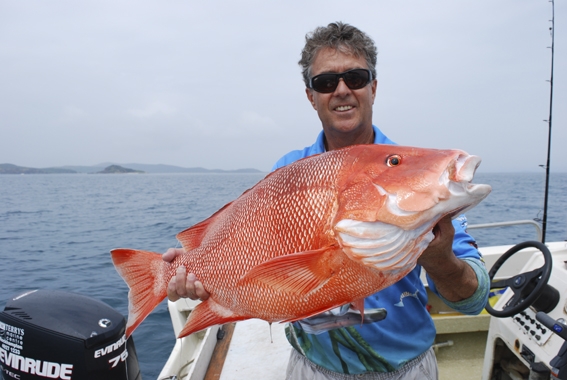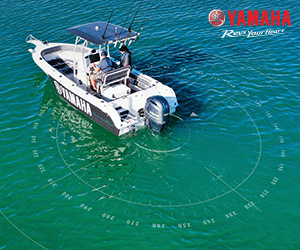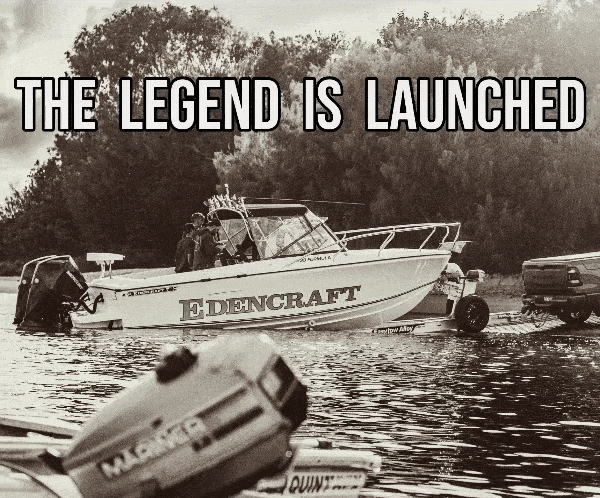Island Stylin’ – Bill Bowtell 2016
The northerly front hit just as we passed Conical Rocks heading north out of Keppel Bay. It was 12 hours ahead of the predicated scheduled forecast. I pulled the throttle back on the big Evinrude and the bow of S-Cape II settled in the uncomfortable slop of the 15-20 knot breeze.
Normally, if I had been with seasoned and experienced fishers, I would have pushed on to our destination, the more northerly islands of Flat and Perforated, still some 40km to our north. But my crew were first-time visitors to this area and relative new comers to offshore boating in not-so-big boats, like my 5.5m Seafarer Viking. I knew the boat well and knew that she could take anything that this sea could throw at her. I wasn’t so sure however, about my crew. We lingered at idle, the sea slopped about. Another set (of waves) rolled through. Both Cam and Gabby bounced from side to side of S-Cape II. The decision was easy.
This was part of a planned five day trip for the young Peninsula-based, Newport, couple who had come up from the SE corner to experience some of what the Capricorn Coast had to offer in the way of fishing and boating, and general holiday aesthetics. This, theirsecond day, was well-off the weather radar. There was no need to put them through the pain of another forty-odd kilometres of front-on, one to one–and–a-half, metre seas just to catch a fish. There were other options. We pushed back into Conical Rocks and took shelter in the lee of the jagged rock form.
Gabby was disappointed. After all, she is the daughter of Maurice Lonzar, and wanted to catch a fish “just like her Dad.” I felt a bit guilty after having raised the hopes of the pair by telling them of the times that Morrie and I fished those northern islands of Flat and Perforated, and showing them photos of our catches of reds, trout, cobia and several big Spanish macks. Morrie’s best fish was a 24kg beauty and Gabby wanted to match it. I felt sure that I could get her a fish – maybe not 24kgs, but certainly one that would give her a workout. The weather didn’t allow it.
Cam was a bit more philosophical about the current situation. We had done a “boys only” trip north the previous morning leaving the Rosslyn Bay harbor at a time that put us at Perforated just as the first hint of a picaninny dawn graced the eastern sky. He was still glowing in the fact that his two 15kg Spanish, taken as the sun made its first golden impression on the cobalt ocean, were not only his biggest ever fish, but that they were also the two biggest fish of the day’s catch. Still, a decision to try a troll around, and wide of Conical Rocks and Sunken Reef, in the hope of scoring a fish for Gabby, was made. She was keen. The sea rolled through.
This area within the Keppel Group of islands has accounted for a broad spectrum of fish species in the past – none moreso than the mackerel species, especially Spanish, greys and doggies. And whilst numbers have declined over the years the current fish bag limits are still regularly achievable when chasing a feed of mackerel.
The wind swung across our northern quarter, varying from a gusty nor-wester to a constant nor-easter. Not good conditions for pelagics, such as Spanish. Steerage atlow speeds was almost impossible, and although we were trolling fresh baits of both ribbonfish and bonito – one high and one at depth – we drew a blank. It was very uncomfortable and the early enthusiasm shown in the boat was quickly fading. So was the color in the faces of the crew. It was time to head in.
The islands surrounding North Keppel Island are beautiful and each in turn has its own unique features, from sandy beaches and oyster encrusted rock platforms to coral fringes and secluded, safe anchorages. In the northerly we headed in towards the northern end of Considine’s Beach on the western side of North Keppel, passing Conical and Corroboree islands on the way and anchored up in 2 metres of water. The sun had fully risen. The wind had swung to a full and consistent nor-east quarter and whistled over the hills that form the backbone of North Keppel Island. S-Cape II moved at anchor in barely a ripple of water. It was like another world. Time to do some searching!
Considine’s Beach is a great place to fish. Over the years it has produced the inevitable range of beach and estuary fish such as bream, whiting and flathead, but it is also a top spot for those island-hoppers and rocky headland dwellers in the form of queenfish, trevally and the lesser mackerels, especially greys and dogs (school). Garfish and long-tom also abound and the next cobia, or bluetooth, caught will not be the last.
One of the added surprised of the entire Keppel Island Group, and not just Considine’s Beach, is the bonefish. Small, but specific, populations of these fish are located in the waters around the islands and give anglers a hell of a fight when they grab a yabby, or soldier crab, meant for a whiting, or bluetooth. Considine’s has its population.
We dived in and had a swim. Gabby and Cam combed the beach for mementos of their stay. Several stingrays patrolled the beach line. Their easy glide not going unnoticed by a school of whiting and two toadfish, who shadowed their every move in the hope of picking up a few tid-bits of food, should the rays stop and grub the bottom. At the thought of food we had a mid morning “brunch” on the rocks in the shade of an overhanging berry-vine. Still the nor-easter persisted.
With any sort of offshore seaward fishing out of the question and the need to get Cam and Gabby onto some form of fishing action, we moved down into the area around Pumpkin and Sloping islands at the southern end of North Keppel.
I had brought a few light rods carrying 8, 10, 14 and 20lb braid on an array of Shimano Stradic, Saros and Sustain spin reels between 2500 and 4000. It was a momentary decision made just in case there were some big oceanic Stout Long Tom in the little bay on the eastern side of Flat Island. My thinking was to try and get both Cam and Gabby onto one of these acrobatic, mini-missile sport fish, specifically as a catch and release sporting option. This gear also suited the fishing I now had in mind.
The inside of Pumpkin Passage is bounded by fringing reefs of both staghorn and plate corals and the smaller reef dwellers such as stripeys, tusk fish, sweetlip, wire-netting cod and coral trout love the place. Although fishing the area can be tricky, especially at anchor and with any sort of wind blowing.
Most times, if I’m chasing fish in the passage, the preferred method is to drift the edges of the reef and roll soft plastics such as Z-Mann Swimmer Z’s in green/yellow combo, Kaitech Jerk Shads in black and white speckled, or my favored Z-Mann Curly Tail in “Opening Night”. But on those days when the fish are finicky I work either fresh dead, or live baits of greenback herring. Everything loves a herring, dead or alive, and they are readily available along the drop-offs around the islands. This day however, with the wind blowing across our port-side quarter and no greenbacks on board, we elected to anchor and float out fresh silvery pilchards.
The fringing reefs around all of the islands are indented with small patchesof sand throughout. These same indented features also occur along the defined edges. Fish favor these areas and from my diving days I have seen gatherings of trout, cod, sharks, bluies and stripeys, sitting out on these patches as if having a meeting. They are the gathering places for fish and observant anglers will search out such location and fish them to their advantage.
S-Cape II was positioned so that she sat just windward of one such hole. The tide was in our favor and the wind shift was almost negligible – it was constant from the nor-east.
Our tackle was first class; G-Loomis rods and Shimano reels with high quality Platypus and Fins braid lines and Sunline shock leader, but our terminal tackle was basic – standard tinned 4/0 Mustad 4200 hooks and 0 size pea sinkers. Three 4/0’s were ganged, the pea sinker slipped onto the shock leader, the hooks tied and a big silvery-grey WA pilchard set.
Gabby was excited with her first fish – a wire netting cod – big for its specie at 37cms. In days gone by this fish would have made the icebox for they are succulent eating. But their size limit is now 38cms and their numbers are now dominating these shallow continental reef areas, for they are a primary predator in these shallow reef areas. Two grassy sweetlip followed on the pilchard baits, one to Gabby and one to Cam, before I chipped in with a 42 cm stripey which nailed a green/yellow Z-Mann SwimmerZ that I was working back behind the drifting baits. The next drop produced another, showing the effectiveness of working baits and plastics in tandem.
I do this quite often. It stands to reason that when bait fishing not all of the bait is consumed, and in fact, much of it is torn off and distributed around the area you are fishing. Some of this stripped bait is eaten by other fish, whilst some of it drifts away. This is where I like to work a lure such as a soft plastic, or vibe. It works.
It was getting near lunchtime and the run had dropped out of the tide. The baits were dropping all the way to the bottom and the small Angelfish and coral wrasses gave them so quarter. It was time to try different tactics.
Both Cam and Gabby had put a nice tray of succulent eating fish on board and were very happy with their efforts, but I wanted to try and get them, especially Gabby onto a hard running pelagic – in particular a Spanish. It was a tough call given the time of day, the stage of the tide and the wind and sea conditions.
We moved to the eastern entrance of Pumpkin Passage, staying wide of the designated Marine Park “green zone” and did a troll with the wind across the eastern face of Pumpkin Island and down along the deep southern face of Sloping Island. This is a good area for very big Spanish macks when the wind is from the northern sector. We took a blistering strike.
The Sabre short-stroker rolled back hard in the horizontal holder and the motor was “gunned” to set the hooks. It was solid. Gabby took the rod and felt the weight of the fish. There was a tentative squeal of delight, before the fish swept in a wide arc beyond Sloping Island and to the south. The wind pushed the boat in the same direction and Gabby locked her knees under the gunwales of S-Cape II, and held on. The pink squid skirt slid up the line and could be seen as a marker indicating the directional movement of the big fish.
The next instant the fish was gone! Tuna erupted everywhere – Longtails!
Gabby sat back on the icebox, dejected and exclaimed, “What went wrong?” and wound the line in. It was cut clean.
“Nothing” I said, “Another fish hit the pink squid skirt. It was out of your control.”
That was an opportunity lost. We tried for another half an hour without any interest and gave it away.
Over the next couple of days we worked the southern islands of the Keppel Group in much the same way. The tides were nearing the neaps and the run was almost non-existent, which made the fishing very specific – early dawn and late evening – and then, only for an hour or so at each session. Still trout, more stripeys and even some school mackerel graced the icebox. During the day we swam and picnicked on the beach.
This style of fishing is available all year round and can be conducted under most weather conditions. It is great for visitors and families alike, and is light relief for those more “serious” anglers who regularly fish over the horizon.And then, when the weather is calm and the sea is kind, the place lies wide open to the small boat owner who, with the assistance of an electric motor, can fish these island areas with devastating affect.
There is no end to island sytlin’. It is only limited to your imagination.





